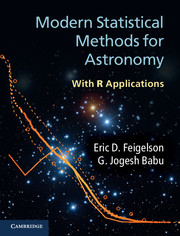Book contents
- Frontmatter
- Contents
- Preface
- 1 Introduction
- 2 Probability
- 3 Statistical inference
- 4 Probability distribution functions
- 5 Nonparametric statistics
- 6 Data smoothing: density estimation
- 7 Regression
- 8 Multivariate analysis
- 9 Clustering, classification and data mining
- 10 Nondetections: censored and truncated data
- 11 Time series analysis
- 12 Spatial point processes
- Appendix A Notation and acronyms
- Appendix B Getting started with R
- Appendix C Astronomical datasets
- References
- Subject index
- R and CRAN commands
- Plate section
Appendix B - Getting started with R
Published online by Cambridge University Press: 05 November 2012
- Frontmatter
- Contents
- Preface
- 1 Introduction
- 2 Probability
- 3 Statistical inference
- 4 Probability distribution functions
- 5 Nonparametric statistics
- 6 Data smoothing: density estimation
- 7 Regression
- 8 Multivariate analysis
- 9 Clustering, classification and data mining
- 10 Nondetections: censored and truncated data
- 11 Time series analysis
- 12 Spatial point processes
- Appendix A Notation and acronyms
- Appendix B Getting started with R
- Appendix C Astronomical datasets
- References
- Subject index
- R and CRAN commands
- Plate section
Summary
History and scope of R/CRAN
The development of R (R Development Core Team, 2010) as an independent public-domain statistical computing environment was started in the early 1990s by two statisticians at the University of Auckland, Ross Ihaka and Robert Gentleman. They decided to mimic the Ssystem developed at AT&T during the 1980s by John Chambers and colleagues. By the late 1990s, R development was expanded to a larger core group, and the Comprehensive R Archive Network (CRAN) was created for specialized packages. The group established itself as a non-profit R Foundation based in Vienna, Austria, and began releasing the code biannually as a GNU General Public License software product (Ihaka & Gentleman 1996).
R grew dramatically, both in content and in widespread usage, during the 2000s. CRAN increased exponentially with ∼100 packages in 2001, ∼600 in 2005, ∼2500 in 2010, and ∼3,300 by early 2012. The user population is uncertain but was estimated to be ∼2 million people in 2010.
R consists of a collection of software for infrastructure analysis, and about 25 important packages providing a variety of important data analysis, applied mathematics, statistics, graphics and utilities packages. The CRAN add-on packages are mostly supplied by users, sometimes individual experts and sometimes significant user communities in biology, chemistry, economics, geology and other fields. Tables B.1 and B.2 give a sense of the breadth of methodology in R as well as CRAN packages (up to mid-2010).
Information
- Type
- Chapter
- Information
- Modern Statistical Methods for AstronomyWith R Applications, pp. 382 - 398Publisher: Cambridge University PressPrint publication year: 2012
